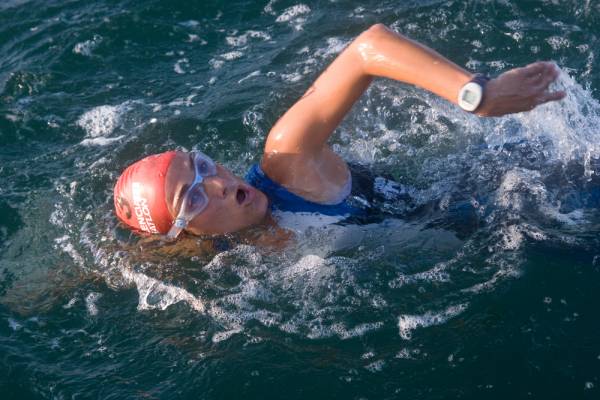Click Here to Try Our Free Swimming Workouts
One of my athlete’s just signed up for Ironman Wisconsin. I have been working with her one-on-one for the past year or so, and I am so happy for her.
While we have a limited amount of time until race day, there are some things we can do to prepare her for completing the swim portion without missing the cutoff. FYI: an Ironman swim is 2.4 miles or 3,800 meters (3.8km).
1. Endurance Build-Up
2.4 miles or 3,800 meters is a long time to be swimming. The average age-group swimmer takes roughly eighty minutes to swim this distance without stopping. And of course you’re going to follow that with a bike ride and full marathon run. So, this means you need to build up your endurance to swim that well for that long.
Your goal should be swim 60-75 minutes a session at least three to four times per week (more if you are not a great swimmer). For my athlete, I will have her swim four to five times a week to prepare for this event. More if time permits, but I know that it isn’t ideal with what is going on in her life. This idea of “more” applies to everyone. If you want to get better swimming, then you need to swim more, swim often, and build your endurance up.
2. Technique and Strength Training
Since we have limited time, fitness is going to be hard to build this quickly, so the big focus will be on strength training and technique. When I mention strength training, I mean working on the stabilizer muscles as well as your upper back. There are plenty of articles on Breaking Muscle that talk about specific exercises for these areas. I will let you determine which is the most appropriate among them, but they all do the same thing – build your muscular endurance.
When we look toward technique, the necessary changes are going to be individual. Just because something works for one person does not mean it will work for you. Everyone is different, which is why working with a coach is the best approach.
But since working with a coach isn’t always possible, the first thing for the average person to focus on is hand entry. Hand entry should be pretty close to the water with a slightly bent wrist that should lead right into what we call early vertical forearm. The idea is to get your forearm as vertical (basically perpendicular to the water line) as quickly as possible. This creates a huge amount of force production to help you move quickly and efficiently through the water.
From there you can work on your hand or arm recovery, but because so much drag is taking place in front of your head, hand entry is the best place to start.
3. Rhythm and Relaxation
The final two pieces of advice I give my athletes is to find a rhythm and relax. These things are linked to both cadence and breathing in a way that can make or break your swimming.
You need to find a rhythm in regards to your cadence in the water, as well as the breathing pattern you select. Different people find different patterns work best. If you find one that works for you, then that is the one you need to stick with. If you change up your rhythm, your body will not like you and you will lose control of your breathing. This will cause you to get into a deficit of breathing (trying to both expel and intake oxygen at the same time).
Getting into a rhythm will also help you relax in the water. Relaxation is key and is related to your cadence in the water. If you feel relaxed with a certain cadence, but it might feel like you look terrible, you need to stop that thinking. If you feel relaxed, then you will look relaxed, and you can stop thinking about what is going on around you. Being relaxed allows you to focus on your race and sets you up for success throughout the day. Just like being relaxed on the bike and on the run.

4. Pre-Race Swimming
I am going to suggest to my client that she plan out the pre-race week in advance. You need to get yourself in the mindset that you will do great in the swim. Being able to swim the actual course the day or two days before the event will also do wonders for you.
The week of Ironman should be shorter repeats of 100-200 yards or meters with about two minutes rest between. You only need to do around 2,000-2,500 distance-wise the week of your Ironman. But in the weeks prior, I would keep the distance up above 3,000.
And that’s it!
Well, that is easier said then done, but hard work and dedication is not something to take lightly. To do well at the longer distance races, you need to train and take care of yourself. I wish you the best and good luck at your Ironman race!
Are you signed up for an Ironman? Which one and when? Post to the comments below.
Click Here to Try Our Free Swimming Workouts
Photos courtesy of Shutterstock.






